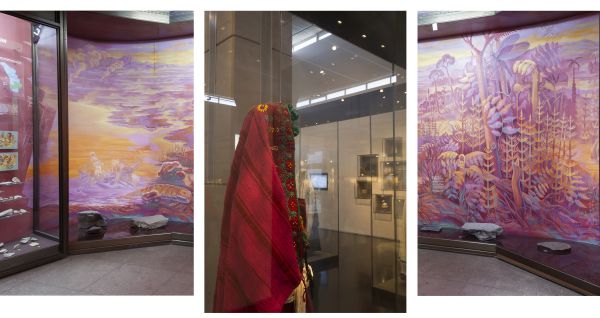Red cap in the Moldovan forest
Store Review (0)PRESENTED BY : Nel
| Frame | None |
|---|---|
| Medium | Digital Print on Canvas |
| Location | Cape Town, South Africa |
| Height | 181.00 cm |
| Width | 373.00 cm |
| Artist | Ilya Rabinovich |
| Year | 2024 |
This triptych is composed of two parts. On the sides is a photo I took at The National Museum of Ethnography and Natural History in Chisinau in 2009, and in the middle is a photograph I took at the Israeli Museum in Jerusalem in 2017.
The Israeli Museum is the largest and most important museum in Israel, accommodating collections according to the encyclopedic museum principle but from a Jewish life perspective. One of its wings, The Jewish Art and Life Wing, is a Jewish ethnography wing that contains religious objects and artifacts related to the "Birth-Marriage-Death" cycle (which is also the name of the permanent exhibition). Because the majority of the artifacts exhibited there were made before Israeli independence and belonged to Jewish diaspora communities, it is evident that the wing exemplifies the narrative of the transformation from separate Jewish religious communities to a united Israeli nation-state.
In that context, between the 1970s and 2000, several academic expeditions were launched from Israeli academia to explore vanishing traditions and clothing belonging to these communities before they immigrated to Israel.
The photograph in the center depicts a traditional Jewish Arab from the Yemenite community. Before the establishment of Israel in 1948, Jews were required to distinguish themselves from Muslims through their clothing.
The National Museum of Ethnography and Natural History is historically the oldest and most significant scientific museum in Moldova, opened in 1904. Over the years, it went through many phases, and after the fall of the Soviet Union and the establishment of the independent Republic of Moldova, a new vision of Moldovan history had to be presented to the public. It took about four years to develop the permanent exhibition, which was created following a UNESCO manual. The museum presents the creation of the universe from the Moldovan perspective, both scientifically and theologically.
This exhibition hall features a display devoted to the so-called Ordovician Period, approximately 500 to 430 million years ago, showcasing paleontological maps, fossils, rocks, and animal bones that illustrate the evolution and diversity of the organic world during the Ordovician Period in the Moldovan region. The murals allow visitors to grasp the proportions of the prehistoric animals, most of which were wiped out by repeated climate changes.
However, beyond a doubt, the most prominent part of the exhibition is the wall painting, which is based purely on fantasy. This element calls the scientific artifacts into question—because if fantasy is visually more dominant than hard scientific evidence, then what is the need for science at all?














